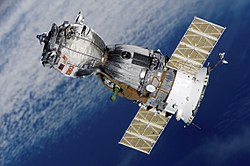 Launch of TMA-17 | |
| Mission type | Crewed mission to ISS |
|---|---|
| Operator | Roscosmos |
| COSPAR ID | 2009-074A |
| SATCAT no. | 36129 |
| Mission duration | 164 days |
| Spacecraft properties | |
| Spacecraft type | Soyuz-TMA 11F732 |
| Manufacturer | Energia |
| Crew | |
| Crew size | 3 |
| Members | Oleg Kotov Timothy Creamer Soichi Noguchi |
| Callsign | Pulsar [1] |
| Start of mission | |
| Launch date | 20 December 2009, 21:52 UTC [2] |
| Rocket | Soyuz-FG |
| Launch site | Baikonur, site 1/5 |
| End of mission | |
| Landing date | 2 June 2010, 03:25 UTC |
| Landing site | Steppes of Kazakhstan |
| Orbital parameters | |
| Reference system | Geocentric orbit |
| Regime | Low Earth orbit |
| Inclination | 51.66° |
| Docking with ISS | |
| Docking port | Zarya nadir |
| Docking date | 22 December 2009, 22:48 UTC |
| Undocking date | 12 May 2010, 13:26 UTC |
| Time docked | 140 days, 14 hours and 38 minutes |
| Docking with ISS (Relocation) | |
| Docking port | Zvezda |
| Docking date | 12 May 2010,13:53 UTC |
| Undocking date | 2 June 2010,00:04 UTC |
| Time docked | 20 days,10 hours and 11 minutes |
 From left to right:Creamer,Kotov and Noguchi Soyuz programme (Crewed missions) | |
Soyuz TMA-17 was a human spaceflight mission to the International Space Station (ISS). TMA-17 crew members participated in ISS Expedition 22 and Expedition 23. The mission ended when the Soyuz TMA-17 capsule landed on 2 June 2010.



